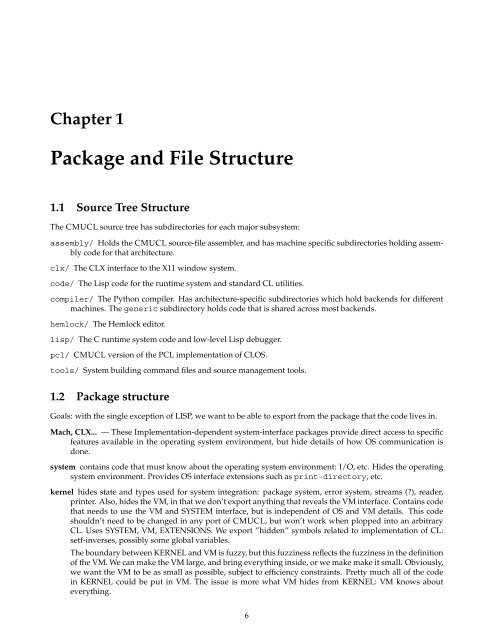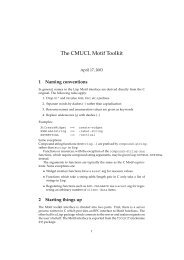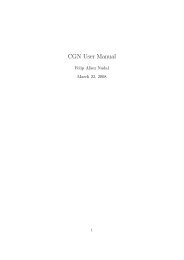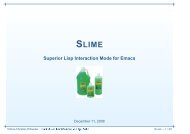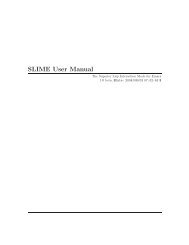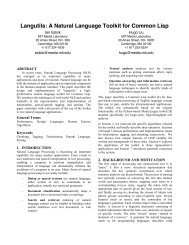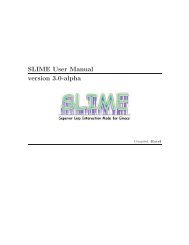Design of CMU Common Lisp.pdf - Common Lisp.net
Design of CMU Common Lisp.pdf - Common Lisp.net
Design of CMU Common Lisp.pdf - Common Lisp.net
You also want an ePaper? Increase the reach of your titles
YUMPU automatically turns print PDFs into web optimized ePapers that Google loves.
Chapter 1<br />
Package and File Structure<br />
1.1 Source Tree Structure<br />
The <strong>CMU</strong>CL source tree has subdirectories for each major subsystem:<br />
assembly/ Holds the <strong>CMU</strong>CL source-file assembler, and has machine specific subdirectories holding assembly<br />
code for that architecture.<br />
clx/ The CLX interface to the X11 window system.<br />
code/ The <strong>Lisp</strong> code for the runtime system and standard CL utilities.<br />
compiler/ The Python compiler. Has architecture-specific subdirectories which hold backends for different<br />
machines. The generic subdirectory holds code that is shared across most backends.<br />
hemlock/ The Hemlock editor.<br />
lisp/ The C runtime system code and low-level <strong>Lisp</strong> debugger.<br />
pcl/ <strong>CMU</strong>CL version <strong>of</strong> the PCL implementation <strong>of</strong> CLOS.<br />
tools/ System building command files and source management tools.<br />
1.2 Package structure<br />
Goals: with the single exception <strong>of</strong> LISP, we want to be able to export from the package that the code lives in.<br />
Mach, CLX... — These Implementation-dependent system-interface packages provide direct access to specific<br />
features available in the operating system environment, but hide details <strong>of</strong> how OS communication is<br />
done.<br />
system contains code that must know about the operating system environment: I/O, etc. Hides the operating<br />
system environment. Provides OS interface extensions such as print-directory, etc.<br />
kernel hides state and types used for system integration: package system, error system, streams (?), reader,<br />
printer. Also, hides the VM, in that we don’t export anything that reveals the VM interface. Contains code<br />
that needs to use the VM and SYSTEM interface, but is independent <strong>of</strong> OS and VM details. This code<br />
shouldn’t need to be changed in any port <strong>of</strong> <strong>CMU</strong>CL, but won’t work when plopped into an arbitrary<br />
CL. Uses SYSTEM, VM, EXTENSIONS. We export ”hidden” symbols related to implementation <strong>of</strong> CL:<br />
setf-inverses, possibly some global variables.<br />
The boundary between KERNEL and VM is fuzzy, but this fuzziness reflects the fuzziness in the definition<br />
<strong>of</strong> the VM. We can make the VM large, and bring everything inside, or we make make it small. Obviously,<br />
we want the VM to be as small as possible, subject to efficiency constraints. Pretty much all <strong>of</strong> the code<br />
in KERNEL could be put in VM. The issue is more what VM hides from KERNEL: VM knows about<br />
everything.<br />
6


